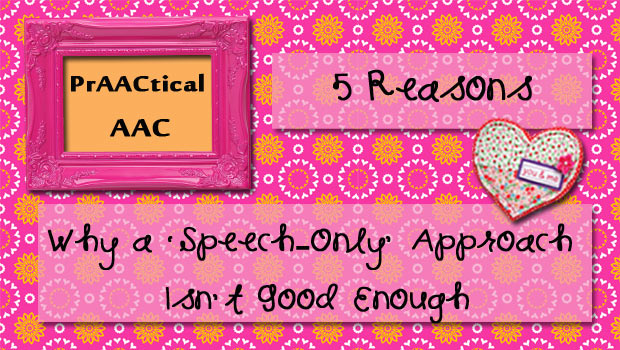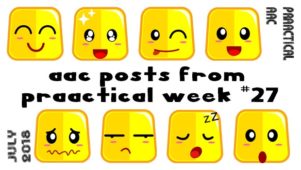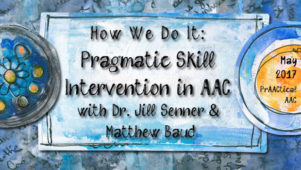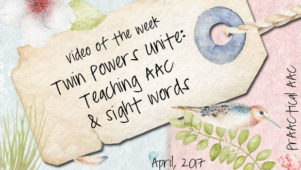5 Reasons Why A ‘Speech-Only’ Approach Isn’t Good Enough

I’m trying to learn to see the good in all things, even when it is not immediately apparent. Lucky for me, the universe just keeps tossing me opportunities to practice my emerging skill in this area.
–
Case in point: A phone conversation with an SLP serving a kindergarten child with developmental disabilities. “We’re working on speech right now, especially oral motor exercises. He can almost extend his tongue past his lips. And in the last year he’s been vocalizing a little louder. Oh, and Mom heard him say ‘Pa’ in the car last week, too! I wish progress were faster but he’s come a long way.”
–
No mention of the fact that he has an expressive vocabulary of, um. ZERO.
–
No consideration that if we continue with this current rate of learning, he’ll be able to say hist first three-word sentence at about the same time he is eligible to vote. No reference to the fact that he has NO way to use language to share his thoughts and ask the questions that are bursting behind his desperate eyes. No awareness that this little guy wants to do what his friends do: he wants to take a turn, give an answer, tease his teacher, tell on his sister. Nope; none of that. “We don’t want to give up on speech.”
–
I hear you, fellow SLP. But what you don’t realize, is that you’ve given up on language development. And if you don’t do something about it soon, your little pupil is going to give up on life.
I hear you, fellow SLP. But what you don’t realize, is that you’ve given up on language development. And if you don’t do something about it soon, your little pupil is going to give up on life.
—
And so, just for you, we have…
–
5 Reasons Why A Speech-Only Approach Isn’t Good Enough
- It delays access to functional communication for people with significant speech difficulties. How long do we expect kids to wait in order to tell us what they’re thinking?
- It is a barrier to active participation in life activities. Who wants to sit by and watch life go on around you? Not the kids we know! They want to be involved.
- It postpones the development of real language skills.
- It doesn’t help us move them toward literacy. The whole world opens up to these kids if we can get them to read and write.
- Because AAC approaches support spoken language.
–
Filed under: PrAACtical Thinking
Tagged With: intervention, SLP
This post was written by Carole Zangari





7 Comments
This is a great post. I travel throughout rural Alaska for my job, and most of my sites only see an SLP 3 times a year. The SLP leaves ideas and does testing, but isn’t there to monitor what is happening with the kids. So many of my teachers try and “make” the kids talk, and they are missing the chance to do so much with language. Once the teachers see that language and speech are not the same thing, the world really starts to open up for my kiddos. I plan on sharing your post with several of my sites.
Thanks, Jennifer. I think the word really is getting out there that AAC approaches are not experimental and using them doesn’t mean we are giving up on speech. It’s a slow process, but we’re getting there.
Amen. Amen. I have seen this so many times in career. For complex kids language is the pathway to speech, if speech is going to be viable communication. The most important goal is communication.
Thanks for your comment, Emily. I think things are changing, but s-l-o-w-l-y. The more education and advocacy we do within our own profession, the better off these kids will be. If we each keep chipping away at this problem bit by bit, maybe we can accelerate the pace of change. Thanks for weighing in. It’s good to hear from kindred spirits.
Hi Dr. Zangari,
These are terrific points! The priority should always be to teach individuals with language/ developmental delays communication, and communication is not synonymous with vocal “speech,” as you clearly demonstrated here. While we never want to completely give up on vocal speech, some individuals do need to be taught another method of communication first so that they can interact with those around them.
I am a Board Certified Behavior Analyst (BCBA), and I have started a website (https://TheBehaviorStation.com) to disseminate resources and science-based information. I would be honored to share this piece with this invaluable information, with your permission. All authorship would remain yours and I would include a link to this original post. Please let me know how I can contact you to discuss more details, or email me at Tiffany@TheBehaviorStation.com.
Best,
Tiffany N Kilby
This sings to me. Succinct, direct…and you just CANNOT argue with the simple obvious logic. Great points. Thank you so much for this!!
You are SO welcome, Tabi!! You are doing amazing things in your schools and I’m delighted if this helps you a little bit in the work that you do.